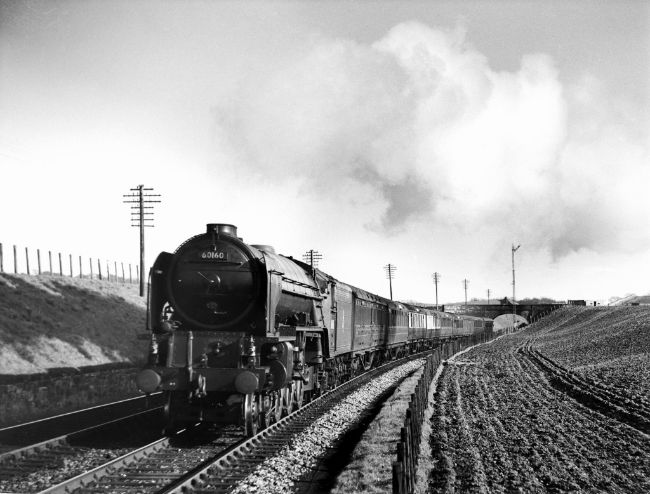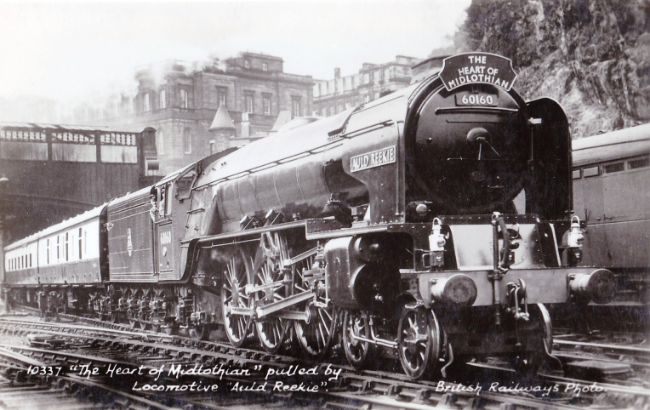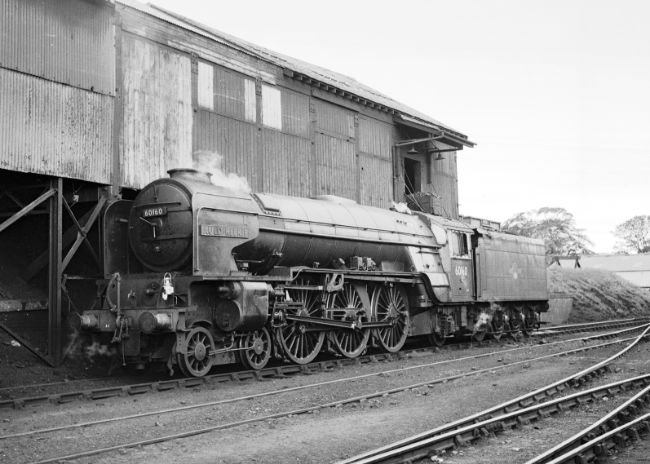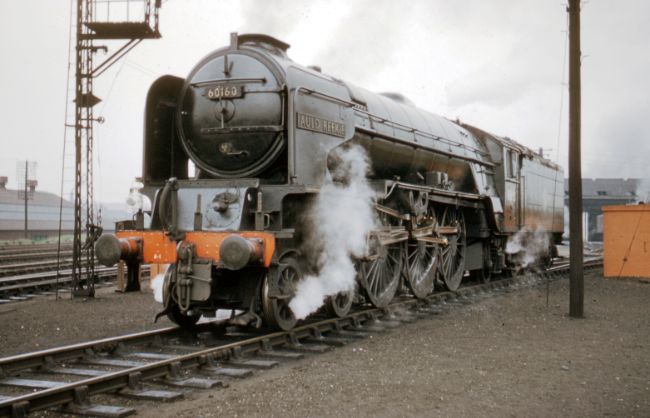No. 60160 was issued with works’ No. 2054 at Doncaster and fitted with boiler No. 10597 during construction, emerging from the works on 2nd December 1949 in BR express passenger blue with black and white lining and the early emblem on the tender. The locomotive was initially allocated to Haymarket shed (HAY) for what was, appropriately, a career spent entirely based in Scotland. At the beginning of 1951 it was briefly transferred to the former Caledonian Railway shed at Polmadie (66A), moving there on 14th January but spending only a short while working Glasgow-Edinburgh-Glasgow diagrams, a stay interrupted by a return to Doncaster for heavy intermediate repairs for all of February before being released back into traffic bearing the name Auld Reekie. The engine could not have had a more suitable name for one which was to spend most of its life working trains to and from Edinburgh for the city is affectionately nicknamed ‘Auld Reekie’, Scots for ‘Old Smoky’, alluding to views from the country of the smoke-covered Old Town. A remark on a poem in an 1800 collection of the poems of Allan Ramsay said, “Auld Reeky. A name the country people give Edinburgh from the cloud of smoke or reek that is always impending over it.” And a character in Walter Scott’s ‘The Abbot’ says “… yonder stands Auld Reekie—you may see the smoke hover over her at twenty miles’ distance.”

Brand new, un-named, No. 60160 is seen at Markinch – W.J.Verden/Rail Archive Stephenson

Auld Reekie prepares to leave its namesake city with the up ‘Heart of Midlothian’, an image which illustrates the problem affecting the headboards when fitted to the original lamp bracket – British Railways
After its brief sojourn at Polmadie the locomotive returned to Haymarket shed (now 64B) on 4th March before being sent back to Polmadie on 16th April. Quite why Auld Reekie wasn’t allowed to settle down initially is not recorded but it was serviced at Haymarket on 2nd May and bull-shined to a high gloss to work the inaugural up ‘Heart of Midlothian’ the following day from Edinburgh to Newcastle (whence No. 60151 Midlothian would take it forward), the train comprising ten of the new Mk1 coaches in immaculate condition. On 4th June No. 60160 was taken into Cowlairs for unclassified repairs, one of only a small number of A1s to be overhauled at the former North British Railway workshops. A1s Nos. 60152, 60160 and 60161 all had spells of duty at Polmadie, principally to work trains over the West Coast Main Line (WCML) to Carlisle or Crewe, working the 18:25hrs postal to Crewe and returning with the 00:50hrs ex-Birmingham as well as occasionally working the 21:25hrs sleeper from Glasgow to Carlisle, returning on the 03:34hrs down. Whilst at the former CR shed the A1s also worked over the former Glasgow & South Western Railway line between Gretna and Glasgow St. Enoch and the Polmadie ‘Top Link’ turn taking the 08:40hrs Glasgow-Edinburgh and returning with 11:37hrs ex-Princes Street. It is recorded that the former LMS men who worked the A1s found them ‘competent’ and surprisingly economical in their use of coal and water.

No. 60160 on shed at Haymarket in early BR green livery – Bill Reed
On 22nd February 1952, Auld Reekie was transferred back to its namesake city where it was destined to remain for the rest of its career, initially at Haymarket shed. Haymarket A1s were allocated regular drivers in the No. 2 Link, replacing A3s in that role, although the sixth engine remained Gresley Class A4 No. 60012 Dominion of New Zealand. Maintained to a very high standard and always immaculate, the Haymarket A1s worked all the former LNER main lines out of Edinburgh but rarely worked south of Newcastle but did find their way to Glasgow, Perth and Aberdeen. No. 60160 was accordingly recorded on the up ‘Flying Scotsman’ on 1st February 1953 and similar East Coast Main Line (ECML) duties until called into ‘The Plant’ for a general over haul for most of March that year, appearing from the paint shop sporting a new coat of BR express passenger green lined black and orange with the early emblem on the tender. Its appearance on the 11:55hrs Hull-King’s Cross and balancing 18:40 King’s Cross-Hull on 2nd April was a very likely to have been a running-in turn before the locomotive was sent back to Edinburgh. The locomotive re-visited Doncaster from 20th May until 1st July 1954 for a general overhaul and its first boiler change, leaving with boiler No. 29816. Settling back into the ECML timetable No. 60160 was recorded on the following named trains during the next few years, the up ‘Queen of Scots’ on 20th November 1954, the up ‘Flying Scotsman’ on 19th February 1955 (returning with the down ‘Scotsman’ from Newcastle the same day) and the up ‘Heart of Midlothian’ on 10th, 11th and 17th March that year. This pattern of activity kept the locomotive gainfully employed until returned to ‘The Plant’ for another ‘General’ during July 1957 which saw the boiler changed for No. 29787, a diagram 117 boiler.

Auld Reekie is coaled at Aberdeen on 16th June 1962 – Bill Reed
ECML workings noted during the late ‘50s included the usual mix of named trains as well as some different turns such as the 13:45hrs express fish Aberdeen-King’s Cross on 7th October 1957 and the Sunday 15:40hrs Aberdeen-Edinburgh on 13th of the same month. After spending December 1958 at Doncaster having a general overhaul (boiler No. 29817 fitted) Auld Reekie was employed on an increasing number of Carlisle trains during 1959, often being serviced at Carlisle Canal shed, a pattern that changed in 1960 as the locomotive reverted to ECML diagrams, usually Newcastle turns with one interesting appearance on the up ‘Starlight Special’ on 15th April that year. General overhauls during March 1960 (boiler No. 29802 fitted) and December 1961 (boiler No. 29859 fitted) interrupted this routine before the arrivals of diesels started to upset it further. Interesting workings during 1962 included some running-in duties after the locomotive’s last general overhaul comprising the 17:17hrs Hull-King’s Cross and return on 5th January and the 10:20hrs King’s Cross-Leeds on the 6th and the 23:20hrs King’s Cross-Edinburgh (ex-Doncaster) on the 8th to return it to its home shed. On 27th September that year the locomotive worked the 10:15 Edinburgh-Leeds but failed at Hellifield, however, whatever ailed No. 60160 must have been minor for it hauled the 1N67 Manchester-Newcastle the next day. With less frontline work available during 1963, Auld Reekie was to be found on increasingly menial duties such as parcels trains on 21st January and 1st June and a freight at York on 8th the same month as well as working a work train that included a breakdown crane on 22nd July. In the company of Nos. 60159 Bonnie Dundee, 60161 North British and 60162 Saint Johnstoun, on 9th September 1963 the locomotive was transferred to St. Margarets shed (64A) to be officially withdrawn on 12th December. Having lingered in store for a couple of months, Auld Reekie was moved to Darlington Works for cutting up during March 1964. A victim of the modernisation plan, the locomotive was another A1 with a shockingly short life, just ten days over 14 years.

No. 60160 displays the quality of Haymarket cleaning – Bill Reed
This history was compiled by Graham Langer based on a database compiled by Tommy Knox, with reference to the RCTS book ‘Locomotives of the LNER Part 2A’ and ‘Yeadon’s Register of LNER Locomotives’ as background.